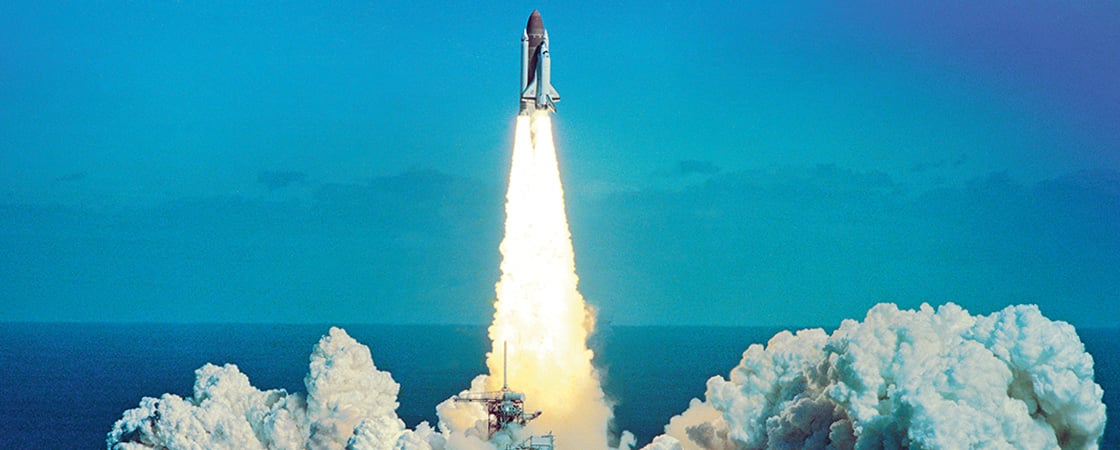It was January 28, 1986, an unusually chilly morning in Florida, and the space shuttle Challenger was about to blast off. Seven crew members were strapped into their seats, bracing for the ear-splitting, teeth-rattling roar of the rockets that would hurtle them into space.
In many ways, this mission would be routine. Challenger was one of five reusable spacecraft constructed for the American space shuttle program, which was now in its 14th year. Each shuttle launched into space, orbited Earth, and then landed back on the ground like an airplane. They were nicknamed “space trucks” because they could carry a lot of cargo as well as many astronauts.
But there was something unique about this mission. One of the astronauts wasn’t an astronaut at all. She was a 37-year-old high school social studies teacher from New Hampshire named Christa McAuliffe. She was to be the first private citizen chosen for a space mission.
The whole country was swept up in the excitement. Just imagine! A teacher going to space! On the day of the launch, kids in classrooms across the country sat at the edge of their seats, eyes glued to the live broadcast. Near the launch site in Cape Canaveral, Florida, crowds gathered outside, eyes cast to the sky to watch what would surely be a thrilling spectacle.
Instead, they were about to witness one of the most shocking disasters in the history of the American space program.
At 11:38 a.m., the rockets fired. Plumes of bright-white steam curled around the launchpad. It would take 10 tons of fuel burning every second to lift Challenger off the ground and into space. It rose slowly at first, sailing straight up. Gaining speed, it rose higher and higher, glinting in the winter sun.
Then catastrophe struck.
A stream of fire suddenly shot out from the side of one of the rockets. And 73 seconds after launch, the fuel tank exploded.
Down on the ground, spectators watched in confusion, trying to make sense of the fireball and strange cloud that had suddenly appeared high up in the sky. Then the awful truth became clear: Challenger had been destroyed. All seven members of the crew had been lost.
Near the launch site, people stopped their cars in the street. Some cried. Others pounded their fists in anger. In schools, students and teachers stared at their televisions in shock. As families grieved and the nation reeled, one question emerged.
How could this have happened?
It was January 28, 1986. The morning was unusually chilly for Florida. The space shuttle Challenger was about to blast off. Seven crew members were strapped into their seats. They braced for the roar of the rockets that would hurtle them into space.
In many ways, this mission would be routine. Challenger was a reusable spacecraft. It was one of five that were made for the American space shuttle program, which was now in its 14th year. Each shuttle launched into space, orbited Earth, and then landed back on the ground like an airplane. They were nicknamed “space trucks.” They could carry a lot of cargo as well as many astronauts.
But there was something unique about this mission. One of the astronauts wasn’t actually an astronaut. Her name was Christa McAuliffe. She was a 37-year-old high school social studies teacher from New Hampshire. She was the first private citizen chosen for a space mission.
The whole country was excited. Just imagine! A teacher going to space! On the day of the launch, kids in classrooms across the country got ready to watch the live broadcast. Near the launch site in Cape Canaveral, Florida, crowds gathered outside. They looked up to watch what would surely be a thrilling spectacle.
Instead, they were about to witness one of the most shocking disasters in the history of the American space program.
At 11:38 a.m., the rockets fired. Plumes of white steam curled around the launchpad. Lifting Challenger off the ground and into space would take 10 tons of fuel burning every second. The shuttle rose slowly at first. Gaining speed, it rose higher and higher, glinting in the winter sun.
Then catastrophe struck.
A stream of fire shot out from one of the rockets. And 73 seconds after launch, the fuel tank exploded.
Down on the ground, spectators watched in confusion. They tried to make sense of the fireball that had suddenly appeared in the sky. Then the awful truth became clear: Challenger had been destroyed. All seven members of the crew had been lost.
Near the launch site, people stopped their cars in the street. Some cried. Others pounded their fists in anger. In schools, students and teachers stared at their televisions in shock. As families grieved and the nation reeled, one question emerged.
How could this have happened?

